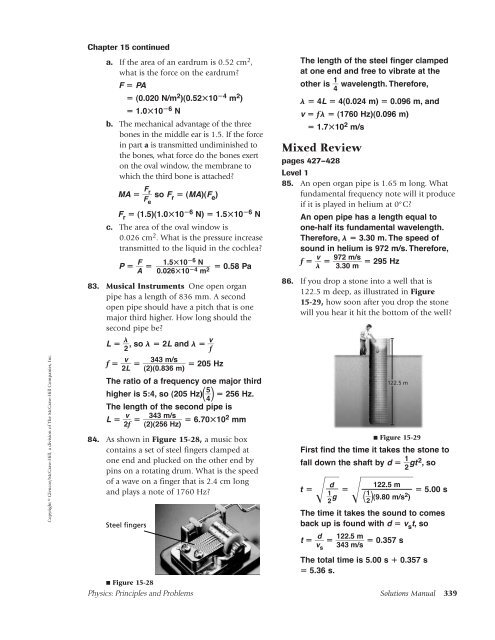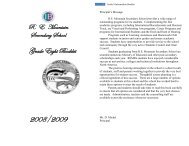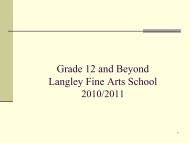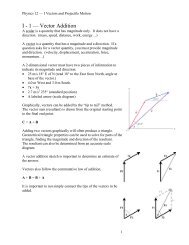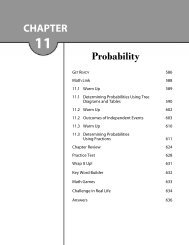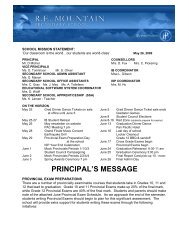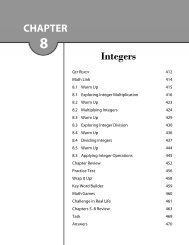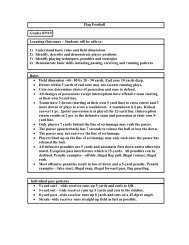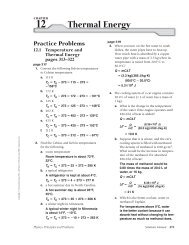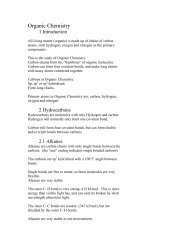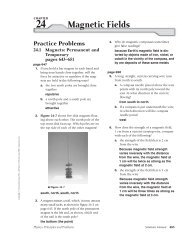Physics Solutions Manual
Physics Solutions Manual
Physics Solutions Manual
You also want an ePaper? Increase the reach of your titles
YUMPU automatically turns print PDFs into web optimized ePapers that Google loves.
Copyright © Glencoe/McGraw-Hill, a division of The McGraw-Hill Companies, Inc.<br />
Chapter 15 continued<br />
a. If the area of an eardrum is 0.52 cm 2 ,<br />
what is the force on the eardrum?<br />
F PA<br />
(0.020 N/m 2 )(0.5210 4 m 2 )<br />
1.010 6 N<br />
b. The mechanical advantage of the three<br />
bones in the middle ear is 1.5. If the force<br />
in part a is transmitted undiminished to<br />
the bones, what force do the bones exert<br />
on the oval window, the membrane to<br />
which the third bone is attached?<br />
Fr<br />
MA so F<br />
F r (MA)(Fe )<br />
e<br />
F r (1.5)(1.010 6 N) 1.510 6 N<br />
c. The area of the oval window is<br />
0.026 cm 2 . What is the pressure increase<br />
transmitted to the liquid in the cochlea?<br />
F 1.510<br />
P 0.58 Pa<br />
A<br />
6 N<br />
<br />
0.026104 m2 83. Musical Instruments One open organ<br />
pipe has a length of 836 mm. A second<br />
open pipe should have a pitch that is one<br />
major third higher. How long should the<br />
second pipe be?<br />
L <br />
,so 2L and v<br />
2 f <br />
v<br />
f <br />
2L<br />
343<br />
m/s<br />
205 Hz<br />
(2) ( 0.836<br />
m)<br />
The ratio of a frequency one major third<br />
higher is 5:4, so (205 Hz)5 4 256 Hz.<br />
The length of the second pipe is<br />
v 343<br />
m/s<br />
L 6.7010<br />
2f<br />
(2)(<br />
256<br />
Hz)<br />
2 mm<br />
84. As shown in Figure 15-28, a music box<br />
contains a set of steel fingers clamped at<br />
one end and plucked on the other end by<br />
pins on a rotating drum. What is the speed<br />
of a wave on a finger that is 2.4 cm long<br />
and plays a note of 1760 Hz?<br />
Steel fingers<br />
The length of the steel finger clamped<br />
at one end and free to vibrate at the<br />
other is 1<br />
wavelength. Therefore,<br />
4<br />
4L 4(0.024 m) 0.096 m, and<br />
v f (1760 Hz)(0.096 m)<br />
1.710 2 m/s<br />
Mixed Review<br />
pages 427–428<br />
Level 1<br />
85. An open organ pipe is 1.65 m long. What<br />
fundamental frequency note will it produce<br />
if it is played in helium at 0°C?<br />
An open pipe has a length equal to<br />
one-half its fundamental wavelength.<br />
Therefore, 3.30 m. The speed of<br />
sound in helium is 972 m/s. Therefore,<br />
v 972<br />
m/s<br />
f 295 Hz<br />
3.30<br />
m<br />
86. If you drop a stone into a well that is<br />
122.5 m deep, as illustrated in Figure<br />
15-29, how soon after you drop the stone<br />
will you hear it hit the bottom of the well?<br />
■ Figure 15-29<br />
First find the time it takes the stone to<br />
fall down the shaft by d 1<br />
2 gt2 ,so<br />
122.5 m<br />
t 5.00 s<br />
1<br />
2 (9.80 m/s2 d<br />
<br />
)<br />
1<br />
2 g<br />
The time it takes the sound to comes<br />
back up is found with d v s t,so<br />
d<br />
t <br />
v<br />
122.5<br />
m<br />
0.357 s<br />
343<br />
m/s<br />
■ Figure 15-28<br />
<strong>Physics</strong>: Principles and Problems <strong>Solutions</strong> <strong>Manual</strong> 339<br />
s<br />
122.5 m<br />
The total time is 5.00 s 0.357 s<br />
5.36 s.


